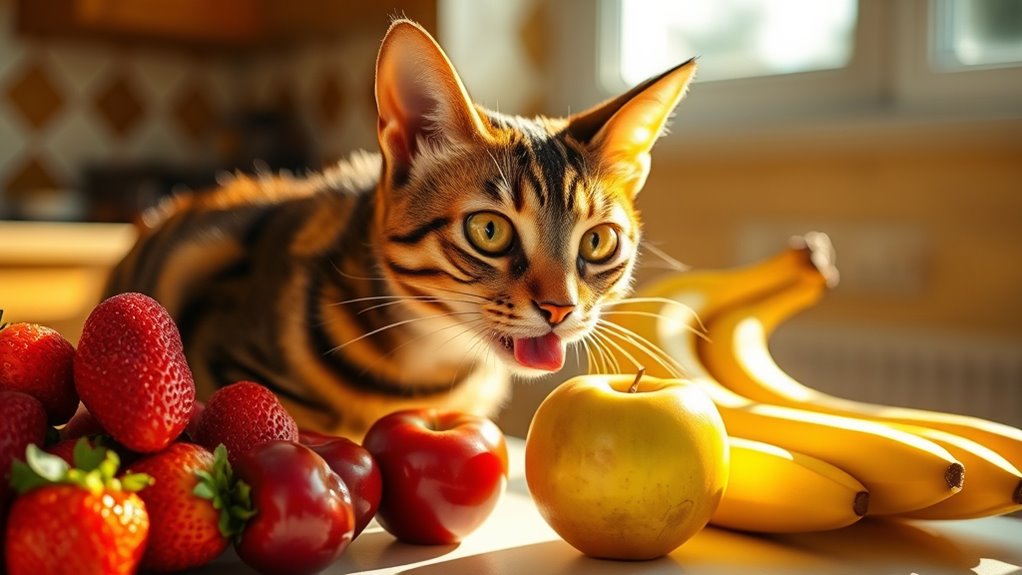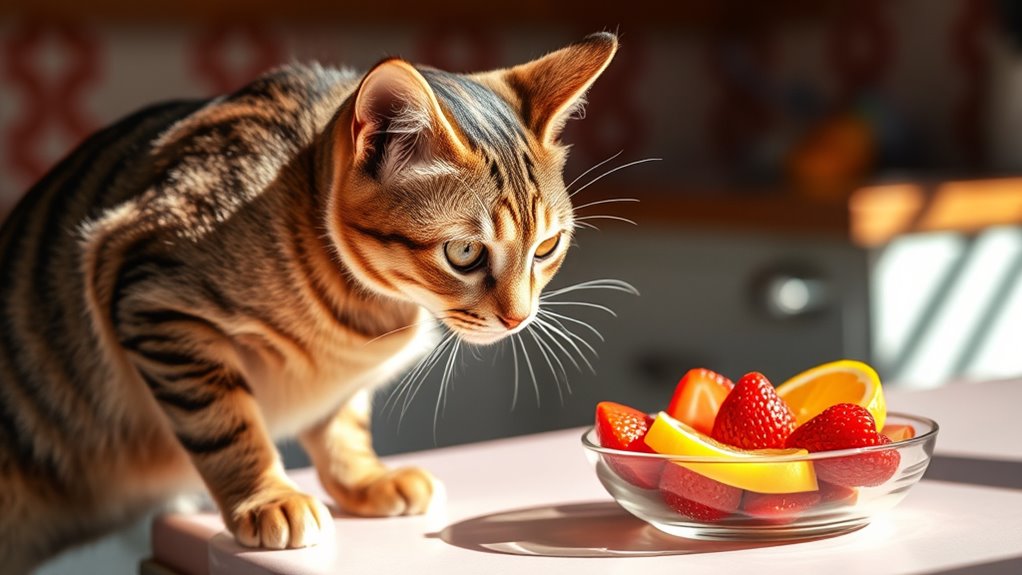Cats can’t taste sweetness because they lack the receptor for sweet flavors on their taste buds. Their taste buds are primarily attuned to savory and meaty flavors, reflecting their evolution as obligate carnivores that thrive on a diet rich in meat. Sugary treats are unnecessary and could even be harmful to their health. If you’re curious about what treats are best for your cat, there’s more to discover about their unique dietary needs and preferences.
Key Takeaways
- Cats lack the receptor for sweetness on their taste buds, making them unable to taste sweet flavors.
- Their taste buds are primarily tuned to savory and meaty flavors, aligning with their carnivorous diet.
- Evolutionarily, cats are obligate carnivores, relying on proteins and fats rather than sugars.
- Sugary foods are unnecessary and potentially harmful to cats, offering no nutritional benefit.
- Treats should be meat or fish-based to align with cats’ natural dietary preferences and needs.

Have you ever wondered if your cat can taste sweetness? It’s a question many cat owners have pondered, especially when we see our furry friends eyeing our sugary snacks. The truth is, cats are quite different from humans when it comes to taste. While you might enjoy a piece of cake or a sweet treat, your feline companion is likely indifferent to sweetness. This is primarily due to their unique evolution and dietary needs.
Have you ever considered whether your cat can taste sweetness? Unlike us, they are indifferent to sugary treats.
Cats are obligate carnivores, which means their diet relies heavily on meat. Over time, their taste preferences have developed to favor savory flavors that come from protein sources. Unlike humans, who have taste buds that can detect sweet flavors, feline taste buds lack the receptor for sweetness. This is an important aspect to consider when thinking about cat nutrition. Your cat doesn’t need sugars in its diet, and introducing sweet foods could actually be harmful.
Understanding feline taste preferences can help you provide a balanced diet for your cat. Cats have evolved to thrive on a meat-based diet, which is rich in proteins and fats. Their taste buds are geared more towards these flavors, allowing them to enjoy the meaty tastes of their food. When you’re choosing cat food, look for high-quality options that prioritize animal protein, as that’s what your cat truly craves. Some commercial cat foods even incorporate flavors that mimic the taste of fresh meat, which can appeal to your kitty’s natural instincts.
While it might be fun to share a bit of your dessert with your cat, it’s vital to remember that sweets don’t align with their nutritional needs. Cats can’t taste sweetness, so they won’t appreciate the flavors the way you do. Instead, focus on providing treats that cater to their carnivorous nature. Freeze-dried meat or fish treats can be excellent options that satisfy their taste preferences.
Frequently Asked Questions
Do Cats Have a Preference for Certain Food Textures?
Yes, cats do have preferences for certain food textures. You might notice your feline friend enjoys specific cat food textures, like pâté or chunks in gravy. These textures can affect how they perceive flavors and their overall enjoyment of meals. Feline taste preferences often lean towards moist, meaty options, which can provide a more satisfying eating experience. Experimenting with different textures can help you discover what your cat loves most!
Can Cats Taste Spicy Flavors?
Cats can’t taste spicy flavors. Their spicy sensitivity is almost nonexistent, meaning they don’t react to heat like humans do. Instead of enjoying the burn, they focus on more familiar flavors. You might notice your feline friend prefers meaty or fishy tastes over the complex notes of spice. When it comes to flavor detection, cats have a unique palate, primarily designed to seek out protein-rich foods, rather than fiery sensations.
Are There Any Safe Human Foods for Cats?
Yes, there are safe human foods for cats! You can offer cooked chicken, turkey, or small amounts of fish. Plain rice or pumpkin can also be good options. However, always keep cat food safety in mind and avoid snacks like chocolate, onions, and garlic, which pose human snack risks. Remember, moderation is key; too much can upset their stomachs. Always consult your vet before introducing new foods to your cat’s diet.
How Do Cats’ Taste Buds Differ From Humans’?
Imagine a world where flavors dance differently on your tongue. Cats experience taste in a unique way, with about 470 taste buds compared to your 9,000. This feline flavor profile means they can’t enjoy sweetness like you do. Instead, they’re wired to prefer meaty tastes, reflecting their carnivorous nature. Those taste bud differences make their culinary experience distinct, focusing more on protein-rich flavors rather than sugary treats that you might crave.
Do Age or Health Affect a Cat’s Taste Perception?
Yes, age and health can definitely affect a cat’s taste perception. As your cat ages, it might experience sensory decline, which can alter its taste preferences. Health-related issues, like dental problems or illnesses, can also impact what your cat enjoys eating. You might notice that your feline friend prefers certain textures or flavors over others, reflecting their changing needs and preferences. Paying attention to these changes is vital for ensuring your cat’s well-being.
Conclusion
While cats can’t taste sweetness, it’s fascinating to know that they have around 470 taste buds, compared to humans’ 9,000! This lack of a sweet taste preference stems from their carnivorous diet, which doesn’t require sugar. So, next time you’re enjoying a sweet treat, remember that your feline friend has a completely different palate. Embrace their unique tastes and offer them some meaty delights instead, because that’s what truly satisfies their cravings!










